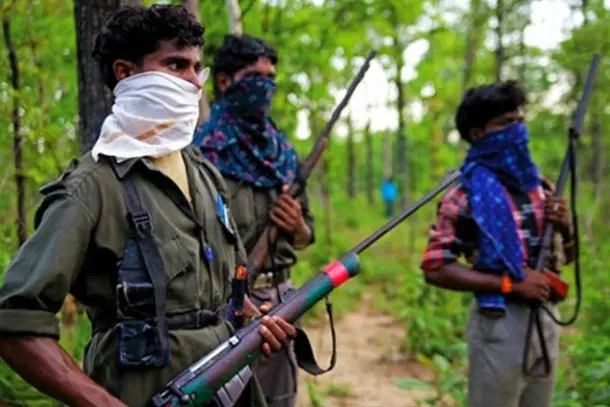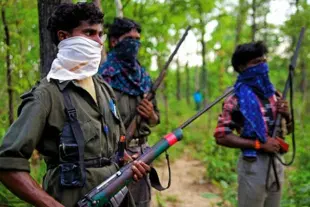Politics
Bastar — The Penultimate Battle For India's Heartland Is Unfolding Now
Ujjawal Mishra
May 29, 2024, 11:55 AM | Updated May 30, 2024, 08:52 AM IST
Save & read from anywhere!
Bookmark stories for easy access on any device or the Swarajya app.


On 3 December 2023, as EVMs voiced what Chhattisgarh felt, far away from the state capital of Raipur, in the dense, desolate forests of Abhujmad (literally, the unknown mountains) a section of top Naxal commanders plotted their next move.
And this wasn't some primitive fighting force, with spears, stones, bows and arrows. No. These Naxal commanders and their associates had modern weapons, computers and tech-enabled communication devices at their disposal.
Labelled the fourth deadliest terror outfit after Taliban, ISIS and Boko Haram, Naxalism has always found allies in its urbane and well-connected counterparts. Be it being termed ‘Gandhians with guns’ by leftist author Arundhati Roy or eulogisation by the likes of Guatam Navlakha.
The story of Bastar isn’t just another tale of micro insurgencies. It is not a story of a region devoid of development either.
Rather, Bastar narrates a sordid saga of disappointment from those who promised to transform it, stealth of those who painted a revolution and then IEDed it to shreds, lies of those who promised holy intervention and yet, sided with the torturers and despite all of this and more, the unbroken perseverance of those who are trying to build it all up, brick by brick.
The Decisive Assault
Just three weeks after 29 Maoists were killed in Kanker district of Chhattisgarh, another 12 Maoists were shot dead in an encounter in the state’s Bijapur district on 10 May. This was followed by some more encounters, each leading to the death, arrest or surrender of Naxals in large numbers.
The scale of the ongoing operations in Bastar can be gauged from the fact that the overall number of Maoists killed in 2024 (till May) is around 120 — the highest since 2019.
Compared to the number of Naxalites killed between 2019 and 2023, when the Congress party was in power in the state, 65, 55, 50, 24 and 24 Naxals were shot dead in 2019, 2020, 2021, 2022 and 2023 respectively, the contrast between the velvet-gloved treatment given to Naxals by the previous Congress administration and the no-tolerance approach of the incumbent BJP government couldn't be more stark.
Birth And Sustenance Of The Naxal Movement
The rise and prevalence of Naxalism in Chhattisgarh is marked by several bloodied milestones. In 2004, the erstwhile Maoist Communist Center of India (MCCI) and the People’s War Group (PWG) merged to form the Communist Party of India (Maoist).
And the already brewing concoction of religious conversion, Maoist violence and tribals being deliberately kept away from the fruits of development gathered greater steam.
Among the many tragedies of the decades-long Congress rule in India, the proliferation of Naxalism and its brutal violence in central India stand out.
Despite then Prime Minister Dr Manmohan Singh calling Naxalism “the single biggest internal security challenge ever faced by the country”, Congress party’s role in backing the Maoist cause for its own political benefits has always been under suspicion. But not in Bastar. Here, the relation between the two is considered almost fraternal.
Be it the murders of BJP workers and leaders in Bastar by Naxals or the unending dog whistling to slaughter BJP leaders in the presence of Congress leaders, Bastar has seen it all.
In the absence of a credible, alternative developmental story for Bastar, the Congress party fell back to its tried and tested strategy of having its opposition eliminated.
Lording Over The Bloody Revolution
Besides the Congress party’s widely acknowledged nationwide patronage to Christianity, the party’s active encouragement to the Church in spreading its wings in India — both geographically and politically — and the subsequent proselytisation, is open knowledge.
Why? Because it is politically easier and more comfortable for the Congress to enhance its political footprint in areas where the electorate is infused with sustained anti-Hindu propaganda. The Congress party’s fortunes are, in a way, tied to areas with Christian or Muslim heavy electorate.
This axiom is even more pronounced today, as the party drifts further and further away from Hindu voters. But what to do about areas where the demography is not on your side? You rig the deck. Meaning, you put the electorate through a conveyor belt of religious conversion.
During the UPA era, an entire web of Churches, NGOs, not for profit organisations, civil society groups and individual philanthropies cropped up across the country and a kind of premium was placed on operating in the tribal areas of central India.
And with the benefit of hindsight, the people of Bastar can make one claim with conviction — under the garb of development and humanitarian assistance, something far more insidious was underway in Chhattisgarh.
The well-oiled machinery touting humanitarianism ran its campaign for religious conversion - mostly subtly, but sometimes, with complete impunity.
Tribal communities would be baited to gather in large numbers with basic household items like grains, oil and kerosene, only to be stealthily or forcefully converted to Christianity at ‘Changai Sabhas’, all with the active support of the local Congress cadre and the magnanimous local Naxal commanders.
As Professor Sangit Ragi said in his paper ‘Missionaries and the Naxal Movement in India’, “What is common between the missionaries, the Marxists and the Maoists is the denunciation of Hindutva as a backward conservative ideology. It suits the missionaries in their campaign against the native religions and fits into the scheme and rationale behind converting the indigenous population. It is interesting to see that while the Maoists have been quite vocal against the Hindu nationalists on the religious and cultural issues, they are silent and mute on the aggressive agenda of cultural and religious homogenisation of Christian missionaries and religious conversion of other sects into Christianity.”
The Not So Non-Governmental Organisations
The logic given for these ‘purely religious’ gatherings by the non-state actors hovering over Bastar, would be that the state left the ‘poor Adivasis’ in such neglect and deprivation that the NGOs and the church had to step in to fill the resultant void.
Lamenting the dispossession and displacement of Adivasis and giving thrust to an artificial class conflict between the innocent tribals and the ‘malevolent Indian State’ was their main plank.
But guess who created the void in the first place? The Church’s secret allies, the Naxals. What exactly do the bands of forest-dwelling Krantikaris, out to protect Jal, Jungle and Zameen, have against the construction of roads and hospitals?
Jonathan Kennedy and Lawrance King noted in their paper ‘Adivasis, Maoists and Insurgency in the Central Indian Tribal Belt’, “in the absence of a strong state, the Naxals control the markets of protection.”
While the Naxals bemoan the lack of development in tribal areas, any attempts to build even the most basic developmental facilities in such areas is routinely met with brutal attacks by the very same Naxals, out to make money by extortion and blackmailing.
Road construction material, mobile towers, schools, primary health centres and Panchayat buildings are set on fire and their operators are frequently murdered in cold blood.
After all this, do the Naxals have any moral standing to complain about lack of development in tribal areas? On what basis can they accuse the state of overlooking tribal development?
Bastar’s Fight, By Its People
In the 2023 assembly elections in Chhattisgarh, the BJP’s biggest promises in Bastar were also indicative of the government’s roadmap, should the party come to power in the state.
Eradication of Naxalism and putting an end to religious conversion were the two emotive promises made by the BJP in Chhattisgarh. And the results showed Bastar’s reception of these promises.
EIght of the 12 seats of Bastar division went to the BJP, which was a significant increase from the party’s zero MLAs between 2018 and 2023 (the party’s lone MLA in Bastar in 2018, Bhima Mandavi of Dantewada was killed by Naxals, months after his victory).
Within days of its victory in Chhattisgarh, the central armed forces and the new state government came like a wrecking ball against Naxalite operations, leading to encounters, arrests and surrenders on an unforeseen scale.
While the government’s firm response to the Maoists may have come as a surprise to many, Union Home Minister Amit Shah had indicated as much, when in 2023, he walked right into the Naxal stronghold of Sukma during the CRPF’s 84th Raising Day event in Jagdalpur. Inspecting a government school, primary health centre and a ration shop, his visit was a sign of the times to come.
Within days of the new government being sworn in in Raipur, the Maoists’ campaign of murder, loot and extortion was met with the State’s fury, while the path of surrender and rehabilitation still remained open for the Naxalites.
It comes as no surprise that the Congress was quick to call the encounters led by security forces ‘fake’, besides calling the Naxals ‘Shaheed’. It hurts when your lieutenants die. Even if they are gun wielding people looking to overthrow the Indian state.
A Better Future On The Horizon?
While this tough treatment of the Naxals is a much needed break from the past, the Chhattisgarh government is still continuing the previously initiated counter-insurgency strategy of winning hearts and minds.
The recently launched Niyad Nellanar Yojana (literally, your good village) is a step in that direction, whereby the villages in a 5 kilometre radius of at least 14 security camps will be provided with over 25 essential services and welfare benefits, including housing benefits, ration cards, essential food items, Ujjwala scheme benefits, education and healthcare facilities, irrigation infrastructure, electricity access, forest rights certificates, and better connectivity enhancement through all-weather roads.
A Chhattisgarh government official, on the condition of anonymity, said that the scheme aims to dispel the anti-security forces propaganda and project these ‘Suraksha camps as Suvidha camps’.
For a painfully long time now, India’s heartland has bled constantly. Innocent and poor tribal communities have been uprooted and thrust into a seemingly never ending cycle of chaos due to the multiple battles raging in Bastar — for physical safety, cultural sanctity and generational identity.
Naxalism in India’s heartland may have been the world’s longest continuing insurgency. But its pillars are now coming apart. As Bastar look at the Indian growth story with hope, the chains which held Bastar’s potential are showing signs of weariness. And that is the ray of hope emanating from India’s tribal heartland.





